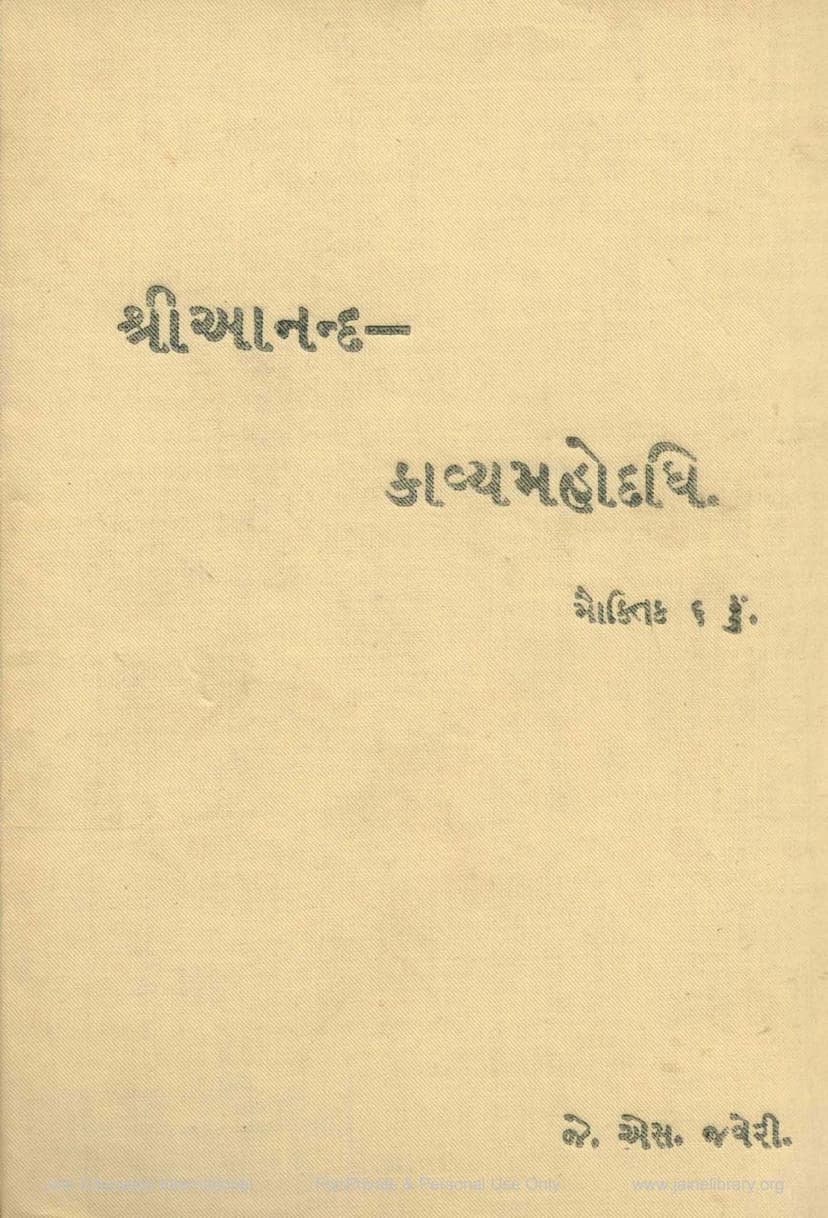Anand Kavya Mahodadhi Part 6
Added to library: September 1, 2025

Summary
Here is a comprehensive summary of the Jain text "Anand Kavya Mahodadhi Part 6" by Jivanchand S Zaveri, based on the provided pages:
Overview of the Book:
- Title: Anand Kavya Mahodadhi (Ocean of Joyful Poetry)
- Part: 6
- Author/Collector/Editor: Jivanchand Sakerchand Javeri
- Publisher: Seth Devchand Lalbhai Jain Pustakoddhar Fund
- Publication Year: 1918 (Vikram Samvat 1974, Christ 1918)
- Edition: 1st
- Copies: 1000
- Price: Rs. 0-10-0
This book is part of a larger series aimed at preserving and publishing ancient Jain Gujarati literature. It is a collection of poems (Rasas) that have been carefully selected and edited by Jivanchand Sakerchand Javeri, with the support of the Seth Devchand Lalbhai Jain Pustakoddhar Fund.
Contents:
The book primarily contains the following three significant Jain Rasas:
- Rupchand Kunvar Rasa: This work narrates the life and spiritual journey of Rupchand, highlighting his birth, childhood, education, valor, and ultimately his devotion and spiritual practice. The narrative is noted for its engaging composition, making it difficult for the reader to put down once started.
- Nal Damayanti Rasa: This Rasa recounts the well-known story of King Nala and Queen Damayanti. The introduction by Dahyabhai Pitambardas Desari and Mahlal Dalichand Desal (B.A., LL.B.) provides a detailed overview of this epic poem. The book also includes comparative notes with other versions of the Nala-Damayanti story, particularly referencing Megharaj's work from the same series.
- Shatrunjaya Uddhar Rasa: This Rasa focuses on the history and significance of the Shatrunjaya pilgrimage site, likely detailing the efforts of various individuals or periods in its restoration or upliftment.
Key Features and Contributions:
- Preservation of Jain Literature: The primary goal of this series and this particular volume is to make ancient Jain literary works accessible to the public, thus preserving a valuable cultural heritage.
- Scholarly Editing and Collection: Jivanchand Sakerchand Javeri is recognized for his effort in collecting and meticulously editing these ancient poems. The introduction by scholars like D. P. Derasari and M. D. Desai adds significant value by providing historical context and analysis.
- Jain Principles: The Rasas included in the collection are presented as integral parts of religious teachings, emphasizing Jain dharma, its rituals, and their benefits. The poets are noted for their dedication to conveying these spiritual goals effectively.
- Linguistic and Literary Value: The collection is praised for its presentation of ancient Gujarati language, offering insights into its evolution and structure. The poems themselves are described as melodious, engaging, and rich in vocabulary and figures of speech, showcasing the poetic skill of the authors.
- Dedication to Scholars: The sixth part is dedicated to the memory of the late scholar Ranjitram Vavalbhai Mehta, acknowledging his deep appreciation for Jain historical and poetic literature and his insightful guidance.
- Government Recognition: Notably, Part 1 of the Anand Kavya Mahodadhi was approved by the Education Department of the Bombay Presidency for secondary school libraries, indicating its educational merit.
- Editorial Notes on Textual Variations: The editor, Jivanchand Sakerchand Javeri, addresses potential textual variations and improvements made during the editing process. He explains that while some older readings were retained, others were modified for clarity or accuracy, often due to multiple manuscript sources and the pressures of printing. He also mentions that not all proposed changes from a reviewer were implemented, as explained in detail with examples of textual variations. The editor acknowledges the challenge of catering to different reader preferences regarding the preservation of ancient forms versus modern readability.
- Inclusion of Supporting Articles: The book includes an "Upodghat" (Introduction) by D. P. Derasari, which discusses the significance of Jain Bhandaras in preserving texts, the evolving attitude towards publishing these works, and the contribution of wealthy patrons like Seth Devchand Lalbhai. It also features articles on the poets Jayanay Sundar and Rupchand Kunvar by M. D. Desai.
Authors of the Rasas:
The Rasas included in this volume are attributed to renowned Jain poets:
- Rupchand Kunvar Rasa: Written by Kaviraj Nayasundar.
- Nal Damayanti Rasa: Written by Bhat Premanand and Meghraj (whose work was published earlier in the same series). The text also references Sanskrit poets like Harsh and Prakrit writers who composed on the Nala-Damayanti theme.
- Shatrunjaya Uddhar Rasa: This might be a compilation or a work by one of the featured poets or a subject of study within the introduction.
Historical and Cultural Context:
The introduction by D. P. Derasari and M. D. Desai provides valuable historical context, discussing the state of Gujarat during the 17th century, the impact of political changes on literature, and the continuous flow of Jain literature despite societal disruptions. It also touches upon the evolving interpretations of ancient texts and the differing opinions within the Gujarati literary community regarding the best approach to their publication.
In essence, "Anand Kavya Mahodadhi Part 6" is a significant contribution to Jain literature, offering a glimpse into ancient Gujarati poetry and the rich spiritual and historical narratives of Jainism, presented through scholarly compilation and editing.